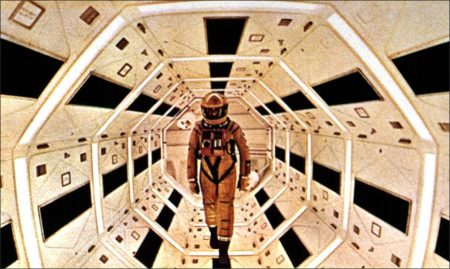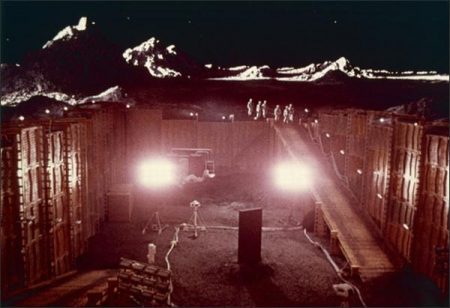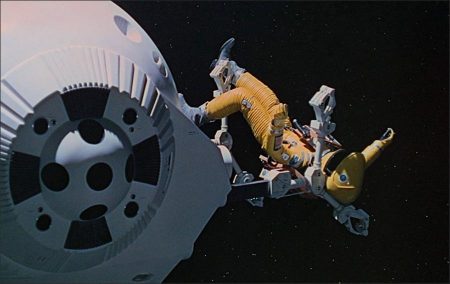Tagline: Man’s colony on the Moon… a whole new generation has been born and is living there… a quarter-million miles from Earth.
2001: A Space Odyssey movie storyline. A black monolith has an affect on humans, the monolith’s effects focusing on two specific time periods. The first period is four million years ago, at the dawn of man. After the appearance of the monolith, the ape men begin to display behavior unknown before then. The second period is the near future, in the year 2001.
There are five astronauts aboard Discovery One, which is on a mission to Jupiter. At the beginning of the mission, the reason for it is unknown to the five astronauts. Three of the astronauts are in hibernation at the start of the mission to preserve the manpower over its entire course, leaving mission commander Dr. Dave Bowman and Dr. Frank Poole as the two manning the spacecraft.
There is another what is often considered “sixth” astronaut on board, HAL 9000 – referred to simply as Hal – the artificial intelligent computer which controls all of the craft’s functions, including the systems keeping the three hibernating astronauts alive. Hal is made all the more astronaut-like as it is given an artificial voice, Hal and the astronauts often having conversations.
A 9000 series computer is considered infallible, any error one has ever made being human caused. Ultimately, Bowman and Poole believe that Hal is malfunctioning, they are unaware that Hal’s behavior is due to knowledge of classified information it has about events at Clavius, a lunar outpost, eighteen months earlier. However, the issue between the astronauts and Hal becomes a fight for survival. The mission in its entirety has profound consequences for the human race.
2001: A Space Odyssey is a 1968 science fiction film produced and directed by Stanley Kubrick. The screenplay was written by Kubrick and Arthur C. Clarke, and was partially based on Clarke’s short story “The Sentinel”. A novel also called 2001: A Space Odyssey, written concurrently with the screenplay, was published soon after the film was released.
The film, which follows a voyage to Jupiter with the sentient computer HAL after the discovery of a mysterious black monolith affecting human evolution, deals with themes of existentialism, human evolution, technology, artificial intelligence, and the existence of extraterrestrial life.
It is noted for its scientifically accurate depiction of spaceflight, pioneering special effects, and ambiguous imagery. It uses sound and minimal dialogue in place of traditional cinematic and narrative techniques, and its soundtrack is famous for its inclusion of a number of pieces of classical music, among them Also sprach Zarathustra by Richard Strauss, The Blue Danube by Johann Strauss II, and works by contemporaneous composers Aram Khachaturian and György Ligeti.
About the Film
2001: A Space Odyssey (1968) is a landmark, science fiction classic – and probably the best science-fiction film of all time about exploration of the unknown. It was released, coincidentally, at the height of the space race between the USSR and the US. It appeared at the same time as NASA’s exploratory Apollo Project with manned Earth orbiting missions – a prelude to orbiting and landing on the Moon with Apollo 11 on July 20, 1969. And it prophetically showed the enduring influence that computers would have in our daily lives.
Director Stanley Kubrick’s work is a profound, visionary and astounding film (a mysterious Rorschach film-blot) and a tremendous visual experience. This epic film contained more spectacular imagery (about what space looked like) and special effects than verbal dialogue. Viewers are left to experience the non-verbal, mystical vastness of the film, and to subjectively reach into their own subconscious and into the film’s pure imagery to speculate about its meaning. Many consider the masterpiece bewildering, boring, slow-moving or annoying, but are still inspired by its story of how man is dwarfed by technology and space.
The first spoken word is almost a half hour into the film, and there’s less than 40 minutes of dialogue in the entire film. Much of the film is in dead silence (accurately depicting the absence of sound in space), or with the sound of human breathing within a spacesuit. Kubrick’s sci-fi experiment intended to present its story almost purely with visual imagery and auditory signals with very little communicative human dialogue (similar to what was attempted in the surreal, fragmented, non-narrative imagery of the Qatsi trilogy – from 1983-2002, from Godfrey Reggio). All scenes in the film have either dialogue or music (or silence), but never both together.
The film is enriched by stunning, pioneering technical effects, and featured orchestral music, presented in movements like in a symphony, from:
Richard Strauss, Also Sprach Zarathustra
Johann Strauss, The Blue Danube Waltz
György Ligeti, Atmospheres, Lux Aeterna, and Requiem for Soprano, Mezzo-Soprano, Two Mixed Choirs and Orchestra
Aram Khatchaturian, Gayane Ballet Suite
2001: A Space Odyssey (1968)
Directed by: Stanley Kubrick
Starring: Keir Dullea, Gary Lockwood, William Sylvester, Daniel Richter, Leonard Rossiter, Margaret Tyzack, Robert Beatty, Sean Sullivan, Douglas Rain, Frank Miller, Bill Weston, Ann Gillis
Screenplay by: Stanley Kubrick, Arthur C. Clarke
Production Design by: Ernest Archer, Harry Lange, Anthony Masters
Cinematography by: Geoffrey Unsworth
Film Editing by: Ray Lovejoy
Set Decoration by: Robert Cartwright
Art Direction by: John Hoesli
Distributed by: Metro-Goldwyn-Mayer
Release Date: April 3, 1968 (United States), May 15, 1968 (United Kingdom)
Views: 880



